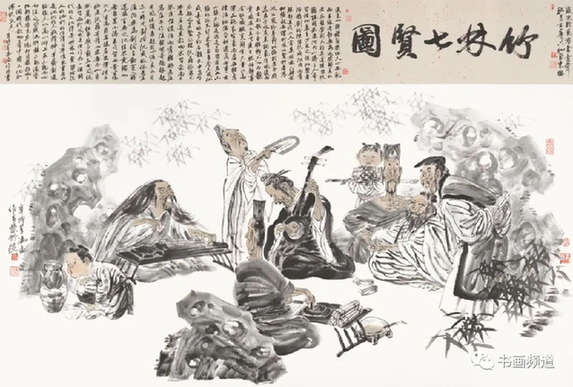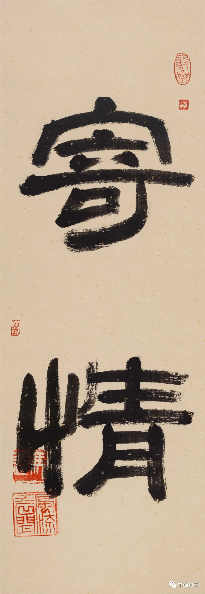
Poster on the exterior walls of the Art Gallery at the Calligraphy and Painting Section in the Beijing Olympic Park (the Olympic Green)
Leaves and flowers are living arts that don’t need artificial decoration. This is a line from the poem Thoughts by Zhang Jiuling (a poet in the Tang Dynasty, 673-740). To be specific, it means that people shall not gild the beauty of leaves and flowers that comes not from artificial making but from natural nourishment, so we’d better leave them in where they are instead of taking them down for temporary appreciation. This philosophy might be a suitable footnote to describe Feng Yuan’s exhibition on classical paintings and calligraphy titled Untold Implications: Expression of Sentiments and Tribute to Sages hosted by the Art Gallery at the Calligraphy and Painting Section in the Beijing Olympic Park.
In the self-preface at the opening part of the exhibition, Feng pointed out the meaning of the theme: as time goes by, in the remaining years of my life, I will try my best to inherit the spirit of Chinese art. Feng sets a high standard for his career, and asks for further suggestions from teachers, friends and art lovers.
Feng wrote this preface in March, but the exhibition has been postponed again and again due to COVID-19 pandemic, even with the opening ceremony rather totally cancelled. The opening time on the poster was first adjusted from 04.27.2022-05.15.2022 into 04.27.2022-05.22. 2022, and remained all the way unchanged. The actual opening of the exhibition was actually 10 days after the ending date announced on the poster. It began on June 1 and lasted for half a month. Feng did not care so much about how many people would walk into the exhibition and appreciate his works, just like natural beauty doesn’t need artificial endorsem

▲Feng Yuan, a recent photo
As a contemporary Chinese painter specialized in human portraits, Feng focused his artistic work on humanistic themes because it is human being that hold aspiration, keep principles, discuss philosophies, share emotions and appreciate the beauty of this world. However, his works on plants and trees are also full of spirits that are echoed with human feelings. Sometimes people can just tell the connotation from the title of his works,such as Listening to the Pine Trees, Seven Sages in the Bamboo Forest, An Ode to the Lotus and Appreciating the Plum blossom, all illustrating the interrelation and harmony between man and nature.
By reading historical records and artistic poems, Feng tries to figure out ancient sages’ lofty ideals, great dedication, sense of responsibility for the nation and their life experiences. He then conveys these understandings through the depiction of sceneries and the portraits of specific objects. His exhibition titled Endless Pursuit with Artistic Traces is, in every sense, a collection of classical masterpieces with rich meaning and vivid expression. It looks like a secluded orchid, blossoming in a remote corner at the Beijing Olympic Park. The exhibition, though focusing on ancient subjects, is actually part of the pursuit by a modern artist for an even higher level of accomplishment. While Feng didn’t deliberately ask for compliment from the audience, visitors to his exhibition would all understand these works and echo with his sentiments, just like the line the flower comes into the hands of a gentleman and they become a perfect match (from An Ode to the Orchid, by Emperor Taizong of the Tang Dynasty) as well as the line a fragrant flower is the best choice for decoration (from Chu Ci, by Qu Yuan,). One would definitely be enriched by the fragrance of flowers and the implication of artistic works, which is true for both Feng himself and the visitors to his exhibition.
The culture of the Qin and Han Dynasties nourishes me with integrity and uprightness while that of the Tang and Song Dynasties cultivates me with a warm and rich temperament. Feng draws inspiration from ancient times for his painting by brush and ink, and then illustrates what he feels through either free-style depiction or exquisite details. The artistic spirit comes from the very bottom of his heart and is then faithfully presented by his drawings. Thanks to his solid academic foundation, his works combine both philosophical connotation and visual profession, which makes Feng Yuan one of the most outstanding artists. In addition, he not only excels at the classical field, but also focuses on the presentation of revolutionary topics and the depiction of ordinary people. This makes him an all-round artist who’s so skillful that multiple philosophies can be harmoniously integrated.
For such an artist, the closing of a specific exhibition is not an end but the beginning of thoughts on his works.
While words cannot fully describe art, let’s now have a glimpse of his exhibition!
Exhibition Hall 1: Expression of Emotion


▲ Great Poets (in four screens)

▲ Listening to the Pine Trees

▲Seven Sages in Bamboo Forest Exhibition
Hall 2: Tribute to Sages


▲ An Ode to the Lotus

▲ Great Philosophers – Confucius

▲ Great Philosophers – Laozi

▲ Eight Great Prose Masters during the Tang and Song Dynasties – Zeng Gong

▲ Eight Great Prose Masters during the Tang and Song Dynasties – Su Shi
Exhibition Hall 3: Ambitious Pursuits


▲ Travelling for Literature Inspiration of Pu Songling (1640-1715)

▲ Chu Ci (A Collection of Songs in the State of Chu) and Qu Yuan

▲ Emperor Wudi of the Han Dynasty: Managing Borderland Territories and Sending Envoys along the Silk Road


▲ Portraits of Ancient Sages – Confucius Handling Scrolls to His Disciples


▲ Portraits of Ancient Sages – Mencius Explaining the Essence of Ren (benevolence, in Confucian philosophy)

▲ Sages
Exhibition Hall 4: Feelings Expressed through Objects


▲ Appreciating the Plum Blossom

▲ Red Beans

▲ Maintain your battling spirit at times of hardship, spread your words when success strolls.

▲ Feelings in the Fall (eight pieces), by Du Fu (poet, 712-770)